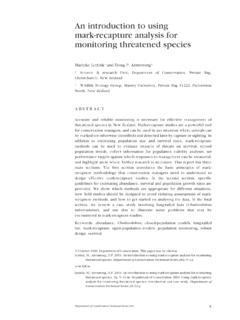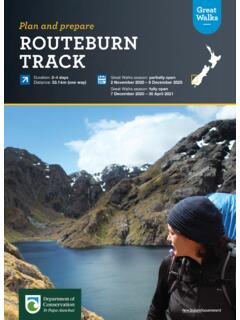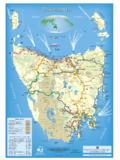Transcription of Introducing North Head North Head Historic Reserve
1 North Head Historic Reserve Hauraki Gulf Marine ParkSelf-Guided WalkPublished by the Department of Conservation Auckland Conservancy Reprinted June 2007 Crown photo: 7 inch summit gun, 1885. Mr C Watt Introducing North HeadNorth Head is considered to be the most significant historical coastal defence site in the country. Its commanding views over the Hauraki Gulf and inner harbour have made it an important lookout and defence site for centuries, first for the early Maori inhabitants of the area, and later for European settlers. First protected as a Reserve in 1972 when it was included in the Hauraki Gulf Maritime Park, the North Head Historic Reserve is now managed by the Department of Conservation. Getting there Ferries run regularly between downtown Auckland and Devonport. Contact Fullers Ferries Devonport Ph 09-367 9118. A tour bus runs from the ferry to North Head and Mount Victoria seven days a week, meeting the ferries from 10am to 3pm. For more informationDOC Auckland Area Office ( North Head)Ph 09-445 9142 DOC Auckland Information Centre Ph 09-379 6476 Fax 09-379 3609email: : 111 Self Guided WalkNorth Head's Self Guided Walk introduces you to a complex of tunnels, guns, searchlight emplacements and other fortifications.
2 These date from the late 1800s up to the time of the Second World War during which time North Head was a major military installation. The numbers on the map in this brochure correspond to numbered markers on the track. Approximate walking time is one hour. North Head Historic ReserveOpen 6am-10pm daily Please Keep dogs on a lead at all times and clear away dog litter. Do not light fires. Do not remove or disturb any artefacts or other Historic remains. These are protected by law. Do not camp in the safe!Because of holes, sudden drops and uneven surfaces, especially in the tunnels, take care when exploring the Reserve and supervise children at all Battery gun. Auckland Weekly News 25 April 18851. Start North BatteryThe tunnel entrances on your right lead into the North Battery (a battery is where guns are sited). North Head s first guns were placed here in 1870. This gun battery was one of three military forts on North Head. It was designed to defend Rangitoto Channel.
3 Follow the green banded posts up the 4-Inch Battery Observation PointThis is an observation post that was part of the North Battery. The mural painted along the top of the windows shows the degree of bearing for the guns. Carry on up the steps. 3. 6-Inch Battery Mk VII BatteryThis gun battery has spent a lot of time on the move! Its construction started in 1904 at the summit. Then a senior officer decided that it should be on this site, so it was completed here in 1910. When Lord Kitchener visited New Zealand on a tour of inspection in 1911, he commented that the battery should have been on the summit! The two 6-inch, MK VII guns that were sited here, were moved to Whangaparaoa in 1940, and moved back again in 1946. They remained in use for practice purposes until 1960, when they were scrapped. Walk up to the Barracks From here you can see the two oldest buildings on North Head. The long, grey wooden building was erected in 1885 by the Armed Constabulary, the forerunners of the New Zealand Army.
4 It was used first as a barracks and then until 1914 as a prison for up to 40 prisoners who provided the labour to build the fortifications. The stone building was the kitchen, built in 1885 (see over). North Head Self Guided WalkThis self-guided walk introduces you to the military history of North Head - the tunnels, guns, searchlights and defences that were placed here to protect Auckland from attack. Much of the equipment was state of the art in its day, but some never became fully operational, and the guns never fired a shot in Mk VII Battery, 1946. W. RuffellNorth Head in the 1870s before the bulding of the fort. Auckland Institute and Museum Russian scareFears of a Russian invasion began to sweep New Zealand in the late 1800s. North Head became one of a number of defence forts that were rapidly set up to protect Auckland. The forts were supported by a torpedo boat based in Devonport, and a minefield that stretched across the harbour from North Head to Bastion Point.
5 Searchlights were stationed at various points around the Head had three forts - the North Battery (to defend Rangitoto Channel), the South Battery (to protect the inner harbour) and Fort Cautley (on the summit). Each fort had one or more heavy guns, an observation post and a high encircling earth walls with bullet-proof gates and barbed wire. The centrepiece of each was an 8 inch disappearing gun, the very latest in military technology in the 1880s. The World WarsDuring World War I the North Head military complex was ready for action, with soldiers living in barracks and tents on site. However, as with the Russian scare, the enemy never arrived, and the guns remained unused - except in practice. At the end of the war, many of the guns (including the disappearing guns) had been declared obsolete, and scrap merchants began to remove World War 2, Auckland's coastal defences had been extended to cover a much wider area. Some of North Head's guns were moved North to Whangaparaoa Peninsula.
6 North Head became the Regimental Headquarters for the whole Hauraki Gulf defence system. Again, Auckland was not attacked, and the guns were used only for training and Head became a base for the Army's Compulsory Military Training Programme during the 1950s. Most heavy guns and equipment were either sold or scrapped - some of the guns in Albert Park and Newmarket are from North Head Gunners 1900. Man on right is the Master Gunner. W. Ruffell Volcanic originsNorth Head is one of the oldest of the approximately 50 cones in the Auckland volcanic field. It was formed over 50,000 years ago in a series of great volcanic explosions. Coastal life North Head is a superb example of New Zealand's rocky coastline. The coast is dominated by hard volcanic rock shelves, sheltered from the open ocean by Rangitoto Island. The rocky shore is made up of a number of different zones, each inhabited by different marine creatures adapted to life in their zone. Pa siteMaori were the first to use North Head for defence purposes.
7 It was one of three cone pa in the Devonport area. The only other remaining site is Takarunga (Mt Victoria.) Ngati Paoa settled North Head until they were attacked and besieged by Nga Puhi in the late 1700s. There are now few sites on North Head where evidence of Maori occupation can be seen. Guiding ships into portNorth Head's views over the entrance to Waitemata Harbour made it the natural choice for a pilot station for the newly established European settlement in Auckland. The station was set up in 1836. RuFollow the colour-banded posts along the white coastal track, the yellow tunnel track and the green summit track (see attached map) to locate the dark green site-numbered posts marking the features described was made of stone to limit the risk of fire. A short film on North Head's history is shown daily, on demand. Further down the slope are 4 more buildings. Three of these date from World War 2 and were either barrack accommodation or offices.
8 The smallest building dates from 1910. Walk on the summit and behind the wooden barracks you can see the three entrances to the tunnels of the Summit Battery. Walk up the steps to the hill 8-inch gunpitIt is easy to see from here why North Head was such a good location for a fort to defend the entrance to the harbour, with its clear views of both the Rangitoto and Motukorea Channels. The round gun pit in front of you once housed an 8 inch disappearing gun. Under the ground are the tunnels and magazines used to store the ammunition for this part of the fort. The concrete building at the highest point of the summit was built in 1937 and was the Fire Commander s Post. During the Second World War all the guns used to defend Auckland were controlled from this building. The other gun pit to the south was first built in 1885 and housed a 7 inch Rifled Muzzle Loader gun. Follow the road down the hill until you come to the big green gun. The little structure with the conical roof was the Observing Station from where the big gun was 8-inch gun and Saluting BatteryThe big gun dates from 1886 and is one of the few remaining 8 inch disappearing guns left in the world.
9 It is called a disappearing gun because as it fired the force of the recoil pushed the gun back underground where it could be reloaded under cover. The energy from the recoil pushed the brown coloured metal shaft into the pressure vessel under the gun where it compressed air and water. This pressure was then released to return the gun to the surface. The big gun fired a 100 kg shell about 6,000 metres. The row of smaller guns here was a saluting battery and fired a 21 gun salute to Queen Elizabeth II on her visit in 1953. It is part of a war memorial to gunners from both World Wars. Carry on down the slope where you will find a small entrance into South South BatteryThe entrance here takes you inside the volcano. You can see the layers of volcanic ash in the walls and ceiling. The caves here were dug by the prison labourers in the 1880s. At the beginning of the Second World War the 40 men who worked the searchlights lived here. Their commanding Officer was Major Ezra Badger and they were known as Ali Badger and his 40 Thieves and this place as Ali s Cave.
10 Walk up the tunnel toward the light until you reach the gun. Walk down the passage behind the gun until you get to a junction of four tunnels. Straight ahead are the stairs leading to the Observing Station, to your right are the magazines are where the ammunition for the gun was stored. The magazines usually had two rooms, an inner one to store the cartridges (bags of gunpowder used to fire the gun), and an outer room used to store the shells. To work in the cartridge store the gunners had to wear special clothing and shoes with no metal fittings that might cause sparks and set off the ammunition. Around these rooms is a small tunnel called a lamp passage. This was used because there was no electricity here in the 1800s and all light came from candle lamps. These were placed in this passage and shone through the little windows which originally had glass in them to prevent the lamps and the ammunition coming in contact. Now walk down the dark tunnel on the left of the passage to the gun.














